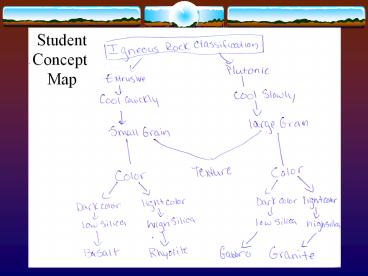Sedimentary Rocks - PowerPoint PPT Presentation
Title:
Sedimentary Rocks
Description:
Student Concept Map Sedimentary Rocks Dr. David Steer Rock Cycle Group discussion time Given: Bag of sedimentary rocks Grouping items Remember this exercise? – PowerPoint PPT presentation
Number of Views:146
Avg rating:3.0/5.0
Title: Sedimentary Rocks
1
Student Concept Map
2
Sedimentary Rocks
- Dr. David Steer
3
Rock Cycle
4
Group discussion time
- Given
- Bag of sedimentary rocks
Group these rocks in some manner.
5
Grouping items
- Remember this exercise?
6
Grouping items
- Group these objects in some logical way.
7
Grouping items
Depositional setting (3) Texture
- Group these objects in some logical way.
Throw
Target
Use only hands
Hit with a stick
Kick
8
Sedimentary Rocks Deposition
- Clastic (detrital) sedimentary rocks
- composed of sediments, rock and mineral fragments
formed when rocks disintegrate at or near the
earth's surface. - Chemical sedimentary rocks
- precipitated from a solution (e.g. sea-water) as
the result of changing physical conditions (e.g.
evaporation). - Biochemical sedimentary rocks
- formed by the actions of living organisms or
composed of the remains of dead organisms.
9
Clastic or Detrital Sedimentary Rocks
- Clastic sediments Classified based on
- coarse grain size particles
- (gravel, includes pebbles, cobbles and boulders),
- medium grain size
- (sand)
- fine grain size
- (silt) gritty feel of sample
- very fine sediment
- (clay) too fine to see
May appear layered
10
Clastic Rocks Classified
Sediment Grain Size (diameter) Sedimentary Rocks
Clay less than 0.0039 mm Shale, Mudstone
Silt 0.0039 to 0.0625 mm Siltstone
Sand 0.0625 to 2 mm Sandstone
Gravel more than 2 mm Conglomerate
11
Review
- Which rock is most likely sedimentary?
Temperature when formed
A
B
Depth
C
E
D
12
Examples of clastic sedimentary rocks
- Mudstone
- Fine grained low energy
- Sandstone
- Medium grained moderate energy
- Individual grains visible in samples
- Conglomerate
- Medium to coarse grained high energy
13
Chemical Sedimentary Rocks
- Chemical sedimentary rocks
- precipitated from a solution (e.g. sea-water) as
a result of changing physical conditions (e.g.
evaporation). - May be difficult to see layers
- Biochemical sedimentary rocks
- formed by the actions of living organisms or
composed of the remains of dead organisms. - Fossils usually apparent
14
Examples of Biochemical Sedimentary Rocks
- Limestones
- form when marine organisms die and their
skeletons accumulate.
- Coal
- forms when land plants die and their organic
tissue accumulate.
15
Concept Map
- Construct a concept map that guides you through
classifying a sedimentary rock.
Classify these rocks.































